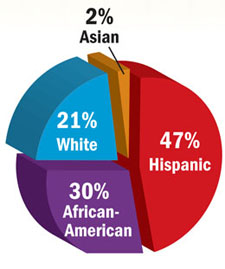
Copiague's Walter G. O’Connell High School
is one of the most diverse schools on
Long Island: Sixty-eight percent of students
qualify for subsidized lunches due to family
income. The community has a large population
from the Dominican Republic and Poland.
People talk about changing a school's culture.
For Copiague social studies teacher James Travis, a big breakthrough came when his students created a Facebook page for AP History.
"It shows such a camaraderie, a single-minded goal to beat the odds," said Travis, whose students are often the first in their families to go to college. "Our kids have to overcome a lot — which makes it all the more impressive to me."
The Facebook page, where students work together on essays and share study tips, is just one brick of what the high-needs district calls its "Road to College" K-12 initiative.
Other bricks include college days when faculty members proudly wear T-shirts from their alma maters, assemblies highlighting graduates who come back and talk about what it's like in college and pep rallies featuring college fight songs to rev up elementary youngsters.
Copiague TA President Tim Gavin, a music teacher who has dressed up as a college mascot gorilla, said the union provides scholarships and has purchased Who's going to college? I am! T-shirts for elementary students.
Every year high school librarian Beth Kattleman creates a college dorm room exhibit — complete with a bed, dirty laundry, lava lamp and sign that says "College Bound" — in a corner of the library. It inspires students to work hard and start thinking about what's next after high school.
"Many of our kids have no idea what a dorm room even looks like," Gavin said. The year-round, district-wide efforts are certainly getting results. This year, the 1,500-student Copiague High School earned the district national recognition as Advanced Placement District of the Year. The honor goes to a district that expands college-level achievement among high school students from diverse ethnic and racial backgrounds, while increasing the percentages of students earning exam scores high enough to qualify for college credit.
"Your scores have gone up faster than any other district in the country for a district your size," Trevor Packer, senior vice president of the national AP program, told students, teachers and school officials at a celebratory assembly.
Packer received big applause when he praised Copiague using one of the longest words in the English language — "honorificabilitudinitatibus," meaning "able to achieve honors."
Getting to that 27-letter superlative has taken dedicated teachers who have made challenging curriculum courses a top priority and open to all, Gavin said.
"We teach work ethic more than anything," Travis said. Students at first gasped at the idea of writing five-page single-spaced essays every week, but such effort is necessary when the AP exam covers 10,000 years of history and requires 70 multiple choice questions and three essays in three hours and five minutes. "We have to work on speed and efficiency," Travis said.
"It really is college-level work." "They push you a lot more, but it's worth it," said Nayquana Mask, who took nine AP courses and is starting her freshman year this fall at Quinnipiac College. "I'm the first in my family to go to college so this is big for me."
Students noted the teachers are willing to help them virtually around the clock, with sunrise review sessions during crunch time, animal cracker snacks — whatever it takes.
"The first year I taught 12 students and it was a tough sell to the kids," said teacher Michelle Penyy.
"Last year, I had 45 kids in two sections and 60 percent passed. The national average is 51 percent." While other districts are cutting AP classes due to budget shortfalls, Penyy noted Copiague has recognized the value of the program and paid teachers extended day compensation for Saturday review sessions.
The district also has expanded middle school offerings to include pre-AP curriculum and increased the rigor of honors classes. High-need Copiague students have made great use of federal funding to cover the AP exams that cost $87 a piece.
NYSUT Vice President Maria Neira noted AP programming can help students learn at a higher level and develop the critical thinking skills and content knowledge needed for college success.
"Unfortunately, in an era of tight budgets, too many districts are viewing AP for all as a luxury they can't afford," Neira said. "Copiague's experience certainly makes the case for not eliminating programs that demonstrate success."